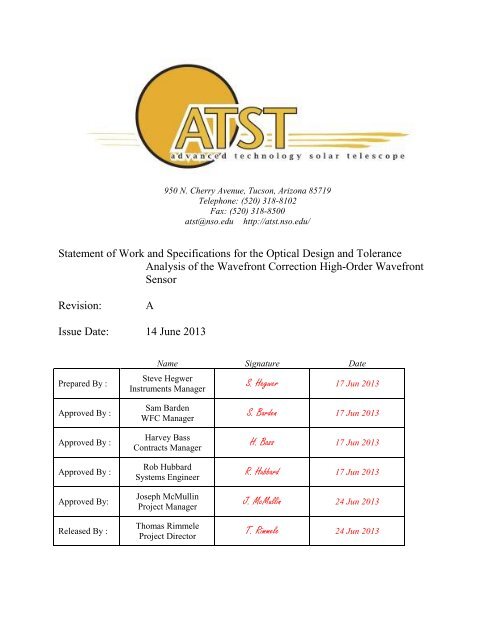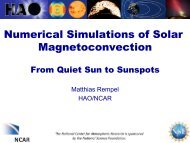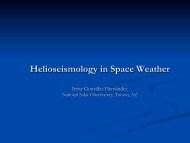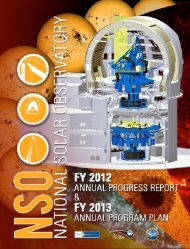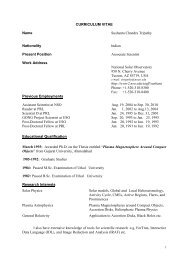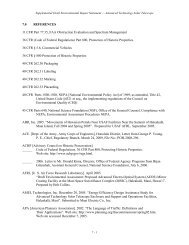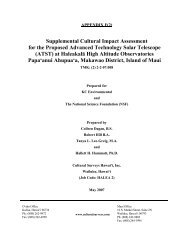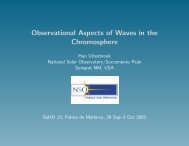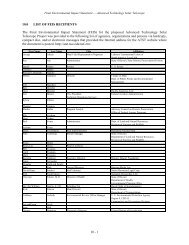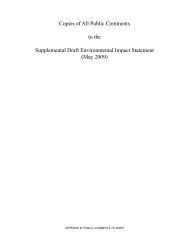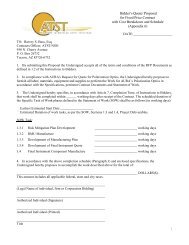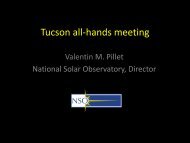Statement of Work and Specifications for the Optical Design ... - ATST
Statement of Work and Specifications for the Optical Design ... - ATST
Statement of Work and Specifications for the Optical Design ... - ATST
Create successful ePaper yourself
Turn your PDF publications into a flip-book with our unique Google optimized e-Paper software.
950 N. Cherry Avenue, Tucson, Arizona 85719Telephone: (520) 318-8102Fax: (520) 318-8500atst@nso.edu http://atst.nso.edu/<strong>Statement</strong> <strong>of</strong> <strong>Work</strong> <strong>and</strong> <strong>Specifications</strong> <strong>for</strong> <strong>the</strong> <strong>Optical</strong> <strong>Design</strong> <strong>and</strong> ToleranceAnalysis <strong>of</strong> <strong>the</strong> Wavefront Correction High-Order WavefrontSensorRevision:AIssue Date: 14 June 2013Prepared By :Name Signature DateSteve HegwerInstruments ManagerS. Hegwer 17 Jun 2013Approved By :Approved By :Approved By :Approved By:Released By :Sam BardenWFC ManagerHarvey BassContracts ManagerRob HubbardSystems EngineerJoseph McMullinProject ManagerThomas RimmeleProject DirectorS. Barden 17 Jun 2013H. Bass 17 Jun 2013R. Hubbard 17 Jun 2013J. McMullin 24 Jun 2013T. Rimmele 24 Jun 2013
Document: SOW <strong>for</strong> <strong>Design</strong> <strong>and</strong> Analysis <strong>for</strong> HOWFSRevision: ADate: 14 June, 2013Change Record:Section(s)Revision Date AffectedDescription <strong>of</strong> ChangeA 21 Mar 2013 All Initial draft <strong>for</strong> approval <strong>and</strong> releasePage 2 <strong>of</strong> 10
Document: SOW <strong>for</strong> <strong>Design</strong> <strong>and</strong> Analysis <strong>for</strong> HOWFSRevision: ADate: 14 June, 2013Contents1. General <strong>Work</strong> Description .................................................................................................................... 41.1 <strong>Design</strong> Optimization Study ........................................................................................................... 41.2 Meetings ........................................................................................................................................ 41.2.1 Meeting Schedule .................................................................................................................. 41.2.2 Meeting Content .................................................................................................................... 41.3 Completion .................................................................................................................................... 52. Deliverables .......................................................................................................................................... 52.1 Reports .......................................................................................................................................... 5- A description <strong>of</strong> <strong>the</strong> work per<strong>for</strong>med. ............................................................................................... 5- <strong>Optical</strong> design description including a requirements compliance matrix . ....................................... 52.2 Contents <strong>of</strong> <strong>the</strong> Data Package; Directory or File: ......................................................................... 52.3 ISO Element Drawing Details ...................................................................................................... 6APPENDIX A. SYSTEM DESCRIPTION ............................................................................................. 81. General Description .............................................................................................................................. 72. Conceptual HOWFS <strong>Optical</strong> <strong>Design</strong> .................................................................................................... 73. HOWFS <strong>Optical</strong> Requirements ............................................................................................................. 83.1 <strong>Optical</strong> <strong>Design</strong> .............................................................................................................................. 83.2 Wavelength Range ........................................................................................................................ 83.3 Pupil Distortion ............................................................................................................................. 83.4 Pupil Imaging Capability .............................................................................................................. 83.5 Pupil Adjustability ........................................................................................................................ 83.6 Sub-Aperture Field <strong>of</strong> View .......................................................................................................... 83.7 Sub -Aperture Count ..................................................................................................................... 83.8 Nominal Lenslet Array Configuration <strong>and</strong> Image Separation ...................................................... 93.8.1 Nominal Lenslet Array Configuration .................................................................................. 93.8.2 Sub-Aperture Image Separation .......................................................................................... 103.9 Plate Scale ................................................................................................................................... 103.10 Plate Scale Adjustability ............................................................................................................. 103.11 Image Distortion ......................................................................................................................... 103.12 <strong>Optical</strong> Per<strong>for</strong>mance at <strong>the</strong> Detector Plane ................................................................................. 103.13 Total Track .................................................................................................................................. 10Page 3 <strong>of</strong> 10
Document: SOW <strong>for</strong> <strong>Design</strong> <strong>and</strong> Analysis <strong>for</strong> HOWFSRevision: ADate: 14 June, 20131. GENERAL WORK DESCRIPTION1.1 DESIGN OPTIMIZATION STUDYThis <strong>Statement</strong> <strong>of</strong> <strong>Work</strong> (SOW) defines <strong>the</strong> tasks <strong>and</strong> deliverables that shall be per<strong>for</strong>med <strong>and</strong> providedby <strong>the</strong> Contractor. This ef<strong>for</strong>t shall be hereinafter referred to as <strong>the</strong> <strong>Work</strong>.The <strong>Work</strong> shall consist <strong>of</strong> <strong>the</strong> Contractor reviewing <strong>and</strong> analyzing <strong>the</strong> provided Wavefront Correction(WFC) High-Order Wavefront Sensor (HOWFS) conceptual design (see Appendix A),makerecommendations <strong>for</strong> optimizing <strong>the</strong> design with respect to: manufacturing feasibility; cost-effectiveness;<strong>and</strong> likelihood <strong>of</strong> achieving per<strong>for</strong>mance requirements, <strong>and</strong> develop a final toleranced design based uponthose recommendations <strong>and</strong> feedback/review by AURA.1.2 MEETINGSContractor shall organize <strong>and</strong> conduct, at a minimum, <strong>the</strong> following meetings:1.2.1 Meeting ScheduleTimeT0T0 + 1 weekT0 + 2 weeksT0 + 4 weeksT0 + 6 weeksEvent*AwardKick Off1 st Progress Review Meeting2 nd Progress Review MeetingFinal <strong>Design</strong> Review MeetingT0 + 8 weeks Final Report MeetingT0 + 9 weeks AURA Report Review periodT0 + 10 weeks Revised Final report due*See Section 1.2.2 <strong>for</strong> specific meeting content <strong>and</strong> objectives1.2.2 Meeting ContentKick-<strong>of</strong>f meeting - to discuss <strong>the</strong> objectives <strong>of</strong> <strong>the</strong> <strong>Work</strong> <strong>and</strong> to ensure that <strong>the</strong> requirements are clear <strong>and</strong>sufficient <strong>for</strong> <strong>the</strong> <strong>Work</strong> to proceed. Contractor shall propose a schedule with a goal <strong>of</strong> submitting <strong>the</strong> FinalReport within 8 (eight) weeks from contract award, followed by a one week AURA review period <strong>and</strong> aone week Contractor response period. The proposed schedule shall include major milestones <strong>of</strong> <strong>the</strong>optical design <strong>and</strong> tolerance analysis.1 st Progress review meeting - to review <strong>the</strong> feasibility, status <strong>and</strong> progress <strong>of</strong> <strong>the</strong> optical design.Contractor shall provide preliminary results, identify any remaining issues, a summary <strong>of</strong> <strong>the</strong>outcomes, a preliminary Zemax model <strong>for</strong> review. <strong>and</strong> any action items resulting from this meeting.2 nd Progress review meeting - to review <strong>the</strong> final optical design <strong>and</strong> review <strong>the</strong> steps <strong>of</strong> <strong>the</strong>tolerancing ef<strong>for</strong>t. Contractor shall provide preliminary results, identify any remaining issues, asummary <strong>of</strong> <strong>the</strong> outcomes, <strong>the</strong> final Zemax model <strong>for</strong> review, <strong>and</strong> any action items resulting from thismeeting.Page 4 <strong>of</strong> 10
Document: SOW <strong>for</strong> <strong>Design</strong> <strong>and</strong> Analysis <strong>for</strong> HOWFSRevision: ADate: 14 June, 2013Final design review meeting - to review <strong>the</strong> tolerance <strong>and</strong> sensitivity analysis <strong>of</strong> <strong>the</strong> final design.Contractor shall provide results, identify any remaining issues, <strong>and</strong> shall summarize <strong>the</strong> outcomes <strong>and</strong>any action items resulting from <strong>the</strong> meeting. The intent <strong>of</strong> <strong>the</strong> final design review meeting is toidentify any remaining issues or areas requiring fur<strong>the</strong>r work be<strong>for</strong>e <strong>the</strong> final report can be submittedFinal report meeting - to review <strong>the</strong> final report. Contractor shall provide a preliminary final report toAURA <strong>for</strong> review <strong>and</strong> comment not later than 1 week be<strong>for</strong>e <strong>the</strong> final review meeting. Should AURAfind deficiencies in ei<strong>the</strong>r <strong>the</strong> preliminary report or <strong>the</strong> meeting contents, AURA will return <strong>the</strong>preliminary report with comments not later than 1 week following final meeting so as to allow <strong>the</strong>Contractor to take any corrective actions.1.3 COMPLETIONThe Contractor shall complete <strong>the</strong> <strong>Work</strong> within <strong>the</strong> 8 week schedule. Weeks 9 <strong>and</strong> 10 are reserved <strong>for</strong>AURA review/comment <strong>of</strong> <strong>the</strong> Final Report <strong>and</strong> <strong>the</strong> Contractor’s responses, respectively.2. DELIVERABLESThe Contractor shall deliver <strong>the</strong> following:2.1 REPORTSA preliminary <strong>and</strong> after revisions, a final report, in electronic <strong>for</strong>mat ( i.e. .PDF <strong>and</strong>/or MS Word) thatshall contain:- A description <strong>of</strong> <strong>the</strong> work per<strong>for</strong>med.- <strong>Optical</strong> design description including a requirements compliance matrix.- Notable analysis features.- Monte Carlo tolerance analysis description, including error distribution assumptions.- Monte Carlo tolerance results indicating <strong>the</strong> statistical distribution <strong>of</strong> top level per<strong>for</strong>mance <strong>and</strong> asensitivity analysis in tabular <strong>for</strong>m. This shall include fabrication, mounting, <strong>and</strong> alignmenttolerances.- Table <strong>of</strong> compensator ranges.- Conclusion <strong>of</strong> results <strong>and</strong> identification <strong>of</strong> tolerances that significantly increase fabricationrisk,cost, <strong>and</strong> mounting/alignment complexity- List <strong>of</strong> contents included in <strong>the</strong> data package.2.2 CONTENTS OF THE DATA PACKAGE; DIRECTORY OR FILE:- The Zemax optical design file <strong>for</strong> <strong>the</strong> final design including a lookup table <strong>for</strong> <strong>the</strong> position <strong>of</strong><strong>the</strong> triplet lenses as a function <strong>of</strong> zoom.- A lookup table <strong>of</strong> <strong>the</strong> position <strong>of</strong> <strong>the</strong> Cooke elements <strong>and</strong> o<strong>the</strong>r components as a function <strong>of</strong>zoom.- Drawings directory: contains <strong>the</strong> optical element drawings in ISO 10110 PDF <strong>for</strong>mat.- WFC tolerance models: <strong>the</strong> Zemax models used to generate <strong>the</strong> tolerance RMS wavefronterror sensitivities <strong>and</strong> to run <strong>the</strong> Monte Carlo analysis. This contains <strong>the</strong> Zemax ToleranceData Editor table <strong>of</strong> values.- WFC element drawings: <strong>the</strong> Zemax models that contains <strong>the</strong> ISO 10110 element drawings.Page 5 <strong>of</strong> 10
Document: SOW <strong>for</strong> <strong>Design</strong> <strong>and</strong> Analysis <strong>for</strong> HOWFSRevision: ADate: 14 June, 2013- Tolerances run listings .txt: <strong>the</strong> output files generated by running <strong>the</strong> tolerance analysis in <strong>the</strong>WFC Zemax tolerance models.- Zemax directory: contains <strong>the</strong> scripts (.tsc), merit functions (.mf), <strong>and</strong> dialog settings (.top)used in <strong>the</strong> analysis.2.3 ISO ELEMENT DRAWING DETAILS- ISO element drawings <strong>for</strong> <strong>the</strong> WFC transmission optics shall include AR coatings with
Document: SOW <strong>for</strong> <strong>Design</strong> <strong>and</strong> Analysis <strong>for</strong> HOWFSRevision: ADate: 14 June, 2013APPENDIX A : SYSTEM DESCRIPTION1. GENERAL DESCRIPTIONAs illustrated in Figure-1, <strong>the</strong>re are four major sub-systems within <strong>the</strong> WFC optical system that sharecommon feed optics. The common feed optics include <strong>the</strong> BS-1 beam-splitter, two unique <strong>of</strong>f-axisparabolas (OAP-1 <strong>and</strong> OAP-2), <strong>and</strong> two fold mirrors (FM 1 <strong>and</strong> FM 2). The four sub-systems include: <strong>the</strong>high order wavefront sensor (HOWFS), <strong>the</strong> low order wavefront sensor (LOWFS), <strong>and</strong> two contextviewer (CV) configurations.Figure-1 WFC Overview2. CONCEPTUAL HOWFS OPTICAL DESIGNThe figure below is a conceptual design to help convey <strong>the</strong> approach <strong>and</strong> requirements. The systembegins at <strong>the</strong> focal plane located at <strong>the</strong> 10 arc-sec FOV field stop.The first Cooke triplet in principle collimates <strong>the</strong> focal plane located at <strong>the</strong> field stop <strong>and</strong> produces a pupilwhere <strong>the</strong> Shack-Hartman lenslet array is placed. Two elements <strong>of</strong> <strong>the</strong> first Cooke triplet piston to adjust<strong>the</strong> pupil diameter on <strong>the</strong> lenslet array.The collimator lens collimates <strong>the</strong> focal planes produced by <strong>the</strong> lenslet array <strong>and</strong> acts with <strong>the</strong> secondCook triplet to produce <strong>the</strong> desired F# at <strong>the</strong> camera detector. The collimator shall also collimate <strong>the</strong> pupil- allowing <strong>the</strong> 2 nd Cooke triplet to image <strong>the</strong> pupil on <strong>the</strong> detector. Two elements <strong>of</strong> <strong>the</strong> second Cooketriplet piston to adjust <strong>the</strong> F# on <strong>the</strong> detector. This conceptual design requires manual adjustment <strong>and</strong>realignment following <strong>the</strong> Cooke elements piston movements. Note; a VG9 or similar Schott coloredglass filter <strong>of</strong> approximately 3mm think will be located between <strong>the</strong> last Cooke triplet <strong>and</strong> <strong>the</strong> detector.The optical per<strong>for</strong>mance <strong>and</strong> tolerance analysis shall include this optic.Page 7 <strong>of</strong> 10
Document: SOW <strong>for</strong> <strong>Design</strong> <strong>and</strong> Analysis <strong>for</strong> HOWFSRevision: ADate: 14 June, 2013Figure-2 Conceptual <strong>Optical</strong> <strong>Design</strong>3. HOWFS OPTICAL REQUIREMENTS3.1 OPTICAL DESIGNThe HOWFS shall be a Shack-Hartmann wavefront sensor.3.2 WAVELENGTH RANGERequirement: 475-575 nm; Goal: 475-600nm.3.3 PUPIL DISTORTIONMaximum distortion introduced between <strong>the</strong> M10 pupil <strong>and</strong> <strong>the</strong> pupil at <strong>the</strong> HOWFS lenslet array shall beless than 0.11%. The Contractor shall provide a Zemax file that demonstrates compliance.3.4 PUPIL IMAGING CAPABILITYThe collimator lens shall piston to image <strong>the</strong> pupil <strong>and</strong> <strong>the</strong> sub-aperture focal plane images onto <strong>the</strong>detector with no adjustment <strong>of</strong> <strong>the</strong> second Cooke triplet lens elements <strong>and</strong> detector piston. The Contractorshall evaluate <strong>the</strong> feasibility <strong>of</strong> reversing <strong>the</strong> position <strong>of</strong> <strong>the</strong> collimator <strong>and</strong> second Cooke triplet lens.Note: The full pupil diameter on <strong>the</strong> detector should not exceed <strong>the</strong> active sensor dimension <strong>of</strong> 11 mm,but be sufficiently large to image <strong>the</strong> lenslet array.3.5 PUPIL ADJUSTABILITYThe pupil size on <strong>the</strong> HOWFS lenslet array shall be adjustable to within 15% <strong>of</strong> its nominal value using<strong>the</strong> 1 st Cooke triplet.3.6 SUB-APERTURE FIELD OF VIEWEach sub-aperture <strong>of</strong> <strong>the</strong> HOWFS shall have a FOV <strong>of</strong> 10 0.5 arc seconds.3.7 SUB -APERTURE COUNTThe HOWFS shall contain 43 fully-illuminated subapertures across <strong>the</strong> pupil diameter, resulting in a total<strong>of</strong> 1405 fully-illuminated subapertures. For purposes <strong>of</strong> this requirement, a fully-illuminated subapertureis defined as a subaperture whose active lenslet area is ≥ 90% filled by <strong>the</strong> telescope pupil.Page 8 <strong>of</strong> 10
Document: SOW <strong>for</strong> <strong>Design</strong> <strong>and</strong> Analysis <strong>for</strong> HOWFSRevision: ADate: 14 June, 2013Figure-3 Sub-apertures3.8 NOMINAL LENSLET ARRAY CONFIGURATION AND IMAGE SEPARATION3.8.1 Nominal Lenslet Array ConfigurationThe nominal focal length <strong>of</strong> <strong>the</strong> lenslets shall be 56 mm, +/- 1.5mm.The nominal diameter <strong>of</strong> <strong>the</strong> lenslets shall be 0.5mm. The tolerance on lens diameter <strong>and</strong> position are submicron.The Contractor may recommend a departure from <strong>the</strong> nominal focal length <strong>and</strong> diameter. The following<strong>for</strong>mula shall be used to derive a configuration:Focal length = <strong>ATST</strong> optical invariant * # sub-apertures * pitch diameter ^2/ FOV<strong>ATST</strong> optical invariant = 51.5#sub-apertures = 43.2FOV = 10 arc-secondsPage 9 <strong>of</strong> 10
Document: SOW <strong>for</strong> <strong>Design</strong> <strong>and</strong> Analysis <strong>for</strong> HOWFSRevision: ADate: 14 June, 2013FL mm = 51.5 * 43.2* 0.5^2/10 = 55.62 mm (round to zero decimals <strong>for</strong> manufacturing)3.8.2 Sub-Aperture Image SeparationSub-aperture images at <strong>the</strong> detector plane <strong>of</strong> <strong>the</strong> HOWFS shall not overlap each o<strong>the</strong>r, nor shall any twoadjacent sub-aperture images be separated by more than one pixel (11.5 microns).3.9 PLATE SCALEThe final focal plane <strong>of</strong> <strong>the</strong> HOWFS shall have a plate scale <strong>of</strong> 43.48 2.17 arc seconds per mm.Note: <strong>the</strong> HOWFS camera has 11.5 micron square pixels <strong>and</strong> each sub-aperture has a 10 arc secondsquare field <strong>of</strong> view. To obtain 20 pixels across each sub-aperture, <strong>the</strong> final plate scale must be (100.5)/(20 *11.5e-3) = 43.48 2.17 arc seconds/mm.3.10 PLATE SCALE ADJUSTABILITYThe plate scale at <strong>the</strong> final focal plane <strong>of</strong> <strong>the</strong> HOWFS shall be adjustable to within +/- 15% <strong>of</strong> its nominalvalue.3.11 IMAGE DISTORTIONMaximum distortion introduced between <strong>the</strong> lenslet array focal plane <strong>and</strong> <strong>the</strong> detector focal plane shall beless than 0.11%.3.12 OPTICAL PERFORMANCE AT THE DETECTOR PLANEThe detector plane Strehl in each sub-aperture shall be > 0.9 @ 480-nm3.13 TOTAL TRACKThe final detector plane <strong>of</strong> <strong>the</strong> HOWFS shall be no more than 1.5 meters from <strong>the</strong> HOWFS field stop.Page 10 <strong>of</strong> 10


